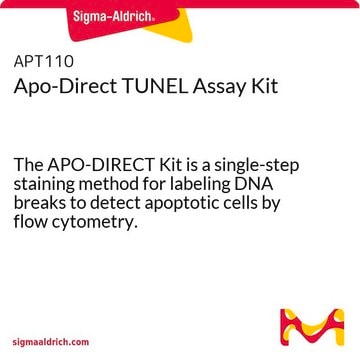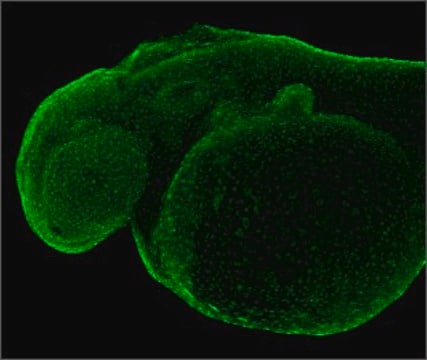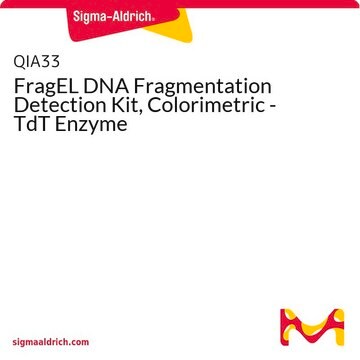11772457001
Roche
TUNEL AP
sufficient for 70 tests, solution, pkg of 3.5 mL
Sign Into View Organizational & Contract Pricing
All Photos(1)
About This Item
UNSPSC Code:
41105600
Recommended Products
form
solution
usage
sufficient for 70 tests
packaging
pkg of 3.5 mL
manufacturer/tradename
Roche
shipped in
wet ice
storage temp.
2-8°C
General description
TUNEL AP is an alkaline phosphatase-labeled antibody used for the in situ detection of apoptosis (programmed cell death) with the TUNEL reaction followed by transmission light microscopy.
The tailing reaction using TdT, also named ISEL (in situ end labeling) or TUNEL (TdT-mediated dUTP nick end labeling), has several advantages in comparison to the in situ nick translation (ISNT) using DNA polymerase:
- Label intensity of apoptotic cells is higher with TUNEL compared to ISNT, resulting in an increased sensitivity.
- Kinetics of nucleotide incorporation is very rapid with TUNEL compared to the ISNT.
- TUNEL preferentially labels apoptotic cells compared to necrotic cells.
Application
TUNEL AP is an antibody that is used to convert fluorescence-based TUNEL assays into colorimetric assays suited for light microscopy. The conversion is performed by binding of an anti-fluorescein antibody to FITC-dUTP. The antibody is labeled with alkaline phosphatase (AP). The AP is visualized with a precipitating substrate, such as Fast Red or NBT/BCIP.
Components
Anti-fluorescein antibody, Fab fragment from sheep, conjugated with alkaline phosphatase (AP). Ready-to-use solution.
Other Notes
For life science research only. Not for use in diagnostic procedures.
Signal Word
Warning
Hazard Statements
Precautionary Statements
Hazard Classifications
Skin Sens. 1
Storage Class Code
12 - Non Combustible Liquids
WGK
WGK 1
Flash Point(F)
No data available
Flash Point(C)
No data available
Certificates of Analysis (COA)
Search for Certificates of Analysis (COA) by entering the products Lot/Batch Number. Lot and Batch Numbers can be found on a product’s label following the words ‘Lot’ or ‘Batch’.
Already Own This Product?
Find documentation for the products that you have recently purchased in the Document Library.
Customers Also Viewed
W Gorczyca et al.
Cytometry, 15(2), 169-175 (1994-02-01)
The predominant mode of either spontaneous or drug-induced death of cells in tumors is apoptosis. A flow cytometric method was developed in our laboratory to identify apoptotic cells, based on labeling DNA strand breaks, which appear as a result of
Beina Chen et al.
Communications biology, 5(1), 105-105 (2022-02-05)
Stroke causes degeneration and death of neurones leading to the loss of motor function and frequent occurrence of cognitive impairment and depression. Lithium (Li+), the archetypal mood stabiliser, is neuroprotective in animal models of stroke, albeit underlying mechanisms remain unknown.
Wu Jiang et al.
Clinical and experimental pharmacology & physiology, 49(1), 122-133 (2021-09-09)
Previous studies reveal that hydrogen sulphide (H2 S) exerts neuroprotection against neurotoxin-induced Parkinson's disease (PD), but the underlying mechanism remains elusive. The present study was aimed to investigate whether H2 S inhibits neuronal apoptosis of substantia nigra with the involvement
Maosheng Xia et al.
Function (Oxford, England), 2(2), zqab003-zqab003 (2021-01-12)
Metal implants are used worldwide, with millions of nails, plates, and fixtures grafted during orthopedic surgeries. Iron is the most common element of these metal implants. As time passes, implants can be corroded and iron can be released. Ionized iron
C D Bortner et al.
Trends in cell biology, 5(1), 21-26 (1995-01-01)
The formation of distinct DNA fragments of oligonucleosomal size (180-200 bp lengths) is a biochemical hallmark of apoptosis in many cells. Recent observations also suggest large DNA fragments and even single-strand cleavage events occur during cell death. These observations have
Our team of scientists has experience in all areas of research including Life Science, Material Science, Chemical Synthesis, Chromatography, Analytical and many others.
Contact Technical Service










